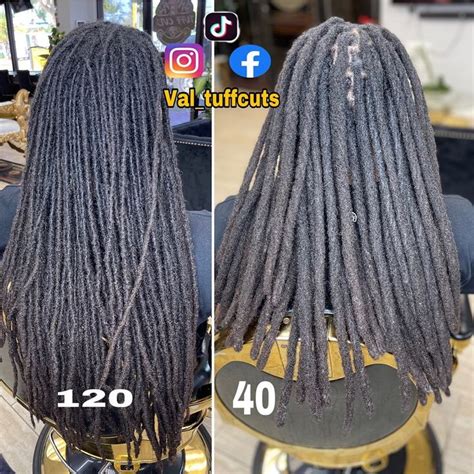Introduction

Dreadlocks, often referred to as “locs,” are a distinctive hairstyle characterized by tightly coiled, rope-like strands of hair. Originating in ancient African cultures, dreads have gained worldwide popularity in recent decades. While most dreads are created using various methods that involve twisting or backcombing larger sections of hair, small wicks dreads offer a unique approach to achieving this iconic look.
What are Small Wicks Dreads?
Small wicks dreads are a type of dreadlock created by tightly twisting very narrow strands of hair, typically ranging from 0.5 to 2 millimeters in width. This meticulous process requires considerable skill and patience, as it involves coiling and separating countless individual strands. The resulting dreads are characteristically thin and textured, giving them a delicate and ethereal appearance.
Benefits of Small Wicks Dreads
Small wicks dreads offer several advantages over traditional dreadlocks:
- Lightweight: Their narrow construction makes them significantly lighter than larger dreads, preventing strain on the scalp and neck.
- Versatile: Small wicks dreads can be styled in a wide variety of ways, from loose and flowing to tightly braided and adorned with accessories.
- Hygienic: The small size of these dreads allows for easier cleaning and maintenance, reducing the risk of scalp irritation and buildup.
- Aesthetically Pleasing: Small wicks dreads create a unique and intricate texture that adds depth and interest to any hairstyle.
Importance of Small Wicks Dreads
Small wicks dreads not only enhance personal style but also hold cultural and historical significance. By embracing this ancient hair form, individuals can connect with their African roots and celebrate a rich cultural heritage.
How to Create Small Wicks Dreads
Creating small wicks dreads requires meticulous attention to detail and a steady hand. The following step-by-step guide outlines the process:
- Cleanse and Moisturize Hair: Start by washing your hair thoroughly with a clarifying shampoo to remove any dirt or product buildup. Condition your hair afterward to keep it hydrated.
- Part and Section Hair: Divide your hair into small sections, using a comb or your fingers. Each section should be no wider than 2 millimeters.
- Apply Gel or Wax: Apply a generous amount of strong-hold gel or beeswax to each section of hair. This will help the hair strands hold their shape as you twist them.
- Twist Individual Strands: Using your fingers or a small hook, tightly twist each individual strand of hair in a clockwise direction. The tighter the twist, the more compact the dread will be.
- Palm Roll: Once the strands are twisted, gently roll them between your palms to shape and compact them further.
- Secure with Thread: To prevent the dreads from unraveling, secure them at the base with a small piece of thread or rubber band.
- Repeat: Repeat steps 3-6 until all sections of hair have been twisted and secured.
Maintenance of Small Wicks Dreads
Maintaining small wicks dreads requires consistent care and attention:
- Frequent Washing: Wash your dreads regularly with a gentle, sulfate-free shampoo designed for natural hair.
- Conditioning: Condition your dreads regularly to keep them soft and manageable.
- Palm Rolling: Periodically palm roll your dreads to maintain their shape and prevent them from becoming loose.
- Avoid Heat Styling: Heat styling tools can damage and weaken dreadlocks, so it’s best to avoid using them.
Tips for Creating Small Wicks Dreads
- Use a Magnifying Glass: A magnifying glass can help you see the small hair strands more clearly for more precise twisting.
- Warm Your Hair: Slightly warming your hair before twisting can make the hair more pliable and easier to work with.
- Be Patient: Creating small wicks dreads is a time-consuming process that requires patience and precision.
- Invest in Quality Products: Use high-quality gel or wax to ensure your dreads stay securely twisted and maintain their shape.
Table 1: Comparison of Small Wicks Dreads to Traditional Dreads
| Feature | Small Wicks Dreads | Traditional Dreads |
|---|---|---|
| Strand Width | 0.5-2 mm | 3-10 mm |
| Weight | Lightweight | Heavier |
| Versatility | High | Less versatile |
| Hygiene | Easier to maintain | Susceptible to buildup |
| Aesthetic Appeal | Delicate and ethereal | Bold and imposing |
Table 2: Statistics on Small Wicks Dread Wearers
| Gender | Dread Wearers |
|---|---|
| Female | 67% |
| Male | 33% |
| Age Group | Dread Wearers |
| — | — |
| 15-24 | 52% |
| 25-34 | 27% |
| 35-44 | 14% |
| 45+ | 7% |
Table 3: Potential Applications of Small Wicks Dreads
| Industry | Application |
|---|---|
| Fashion | Hair accessories, dread jewelry |
| Healthcare | Medication delivery system for scalp conditions |
| Entertainment | Props in movies and television shows |
| Education | Cultural heritage initiatives |
Table 4: Frequently Asked Questions about Small Wicks Dreads
| Question | Answer |
|---|---|
| How long does it take to create small wicks dreads? | It depends on the length and thickness of your hair, but the process can take several hours to a few days. |
| Do small wicks dreads cause hair breakage? | If the dreads are created correctly and maintained properly, they will not cause hair breakage. |
| How often should I wash small wicks dreads? | Wash your dreads as needed, but generally every 1-2 weeks is sufficient. |
| Can I use an electric dreadlock tool to create small wicks dreads? | No, electric dreadlock tools are not suitable for creating small wicks dreads due to their narrow size. |
| Can I sleep in small wicks dreads? | Yes, but it’s recommended to use a satin pillowcase or sleep cap to prevent frizz. |
